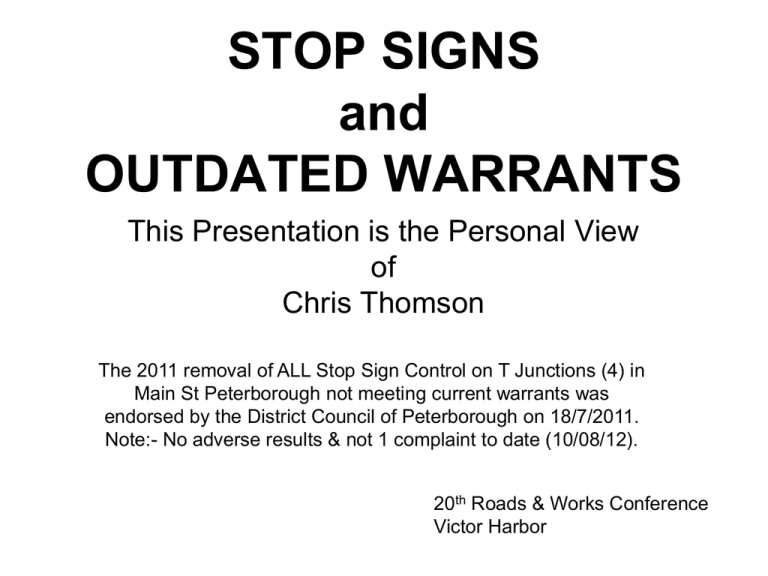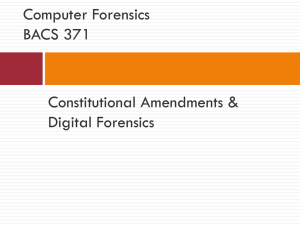stop signs & outdated warrants - Local Government Association of
advertisement

STOP SIGNS and OUTDATED WARRANTS This Presentation is the Personal View of Chris Thomson The 2011 removal of ALL Stop Sign Control on T Junctions (4) in Main St Peterborough not meeting current warrants was endorsed by the District Council of Peterborough on 18/7/2011. Note:- No adverse results & not 1 complaint to date (10/08/12). 20th Roads & Works Conference Victor Harbor Background • 1994, 18 years ago … until the present – The current warrant for Stop signs in AS 1742.2 first appeared in the 1994 edition & the crash component was removed in 1996. – In Jan 2003 the default urban speed limit was lowered from 60kph to 50kph. That reduced the minimum sight distance from 40m to 30m, which further reduced the number of Stop Signs meeting current warrants. – STANDARDS AUSTRALIA did not intend for faded or damaged Stop Signs to be continually replaced without any consideration being given to review, especially given that we are all aware that the warrant for a Stop Sign had changed significantly. – STANDARDS AUSTRALIA trusts that State Road Authorities will act responsibility to ensure Compliance, Uniformity and Credibility, just as they display with line marking. – Line marking, is routinely reviewed and changed, as Standards change. – Why do we not treat Stop Signs in the same manner? • What have our States Road Authority & Local Government done in regards to reviewing outdated Stop Sign warrants since 1994? • Remember, that’s 18 years? I SUGGEST THE FOLLOWING S F A We have to Stop Fooling Around STOP choosing to ignore the issue STOP intentionally avoiding the issue DPTI. South Australia’s Governing Road Authority Our Leaders, have elected to ignore the issue of Outdated Stop Sign Warrants unless there is a major upgrade at the given location whilst continuously citing:• Compliance • Uniformity and • Credibility in any correspondence on the issue whether it be written or verbal in the past 18 years. Local Government Road Authorities • • • • We are no better, we have been NEGLIGENT in our duties as “responsible” road authorities as we have also elected to ignore the issue of Outdated Stop Sign Warrants unless there is a major upgrade at the given location. Compliance Uniformity Credibility are the keys to the effective use of traffic control devices that lead to greater compliance and safety by road users. Uniformity and Credibility will only be achieved if we review and update outdated warrants. SO WHY DON’T WE APPLY THE CURRENT WARRANTS? • Scared of possible public criticism? • The general public's perception is that:SIGNS FIX EVERYTHING and we all know that is far from reality. • Scared of the WHAT IF FACTOR? What if there's an accident shortly after removing a sign that is not warranted? • What happens if a review finds that we should undertake an upgrade of the T Junction or Intersection to fix what stop signs didn’t? • Is it Cost? • Lack of resources to conduct review? • Reluctance to accept change? • Don’t see it as a priority? • Or is it because we just don’t give a shit! Seriously By DOING ABSOLUTELY NOTHING we are ALL being NEGLIGENT As “Responsible Road Authorities” We have a responsibility to ensure:- Compliance Uniformity Credibility THE LACK OF • • • • Compliance Uniformity Credibility Directly leads to DIMINISHING LACK OF CREDIBILITY and Non Compliance which has the potential to create a hazard to road users. The LGAMLS may be defending a Council one day if there’s an accident and someone claims lack of Compliance, Uniformity and Credibility as a contributing factor to their accident. STANDARDS AUSTRALIA • The Standards Australia team comprise of Highly Qualified Traffic Engineers from each States Road Authority. • They have conducted research from around the world and have ended up basing 1742.2 largely on the UK model which has been working fine for decades. • If it works in the UK surely it will work here! SO WHY BE SCARED TO REVIEW? Should the warrant for a Stop Sign NOT be met the following rules apply. • INTERSECTIONS - a GIVE WAY sign shall be used if the warrant for a Stop is not met. • A GIVE WAY SIGN still has a requirement by LAW to STOP if necessary. • There is also nothing in LAW to prevent you stopping at a GIVE WAY sign if so desired. • T JUNCTIONS, if the warrant for a STOP SIGN is not met the T JUNCTION RULE applies. (Special situations, if met, allow for or call for a Give Way sign) • The T JUNCTION RULE still has a requirement by LAW to GIVE WAY and STOP if necessary. There is nothing in LAW preventing you from stopping at a T Junction if so desired. AUSTRALIAN STANDARDS What are they? • Are they Standards where each State and Local Government just picks & chooses which ones they might want to use? • or modify individual ones to suit their own perceived local ideas and ignore the rest? • Is that really going to achieve a truly National Standard throughout Australia? NO • AUSTRALIAN STANDARDS should reflect the same message wherever it is used throughout Australia. • Road users can then be confident that if they approach a Stop Sign, there really is a restricted sight distance issue making it vital that they should Stop. • The same goes for any other form of TCD, it needs to reflect the same message of Consistency, Uniformity and Credibility throughout Australia. • Only then have we achieved:REAL AUSTRALIAN STANDARDS that are truly Uniform and Credible My Objective • Is to convince you, our leaders within Local Government to UNITE in the common goal and strive for:• Compliance, Uniformity & Credibility of ALL traffic control devices, including Stop Signs!! • To have the LGA seek consistency from DPTI and promote consistency within Local Gov’t. Unless we can achieve that we might as tear up the M of LR&TR for TCD’s and AS 1742.2-2009 and just go off and do our own thing. The Minister DPTI Local Gov’t Rail Authorities Examples where Stop Warrants Not Met • Adelaide Example • Palmer Place and Montefiore Hill Rd T Junctions. Recently, in the space of just 6 minutes (on a Sunday Arvo) while I was waiting for my Son outside of Aquinas College I observed a total of 11 cars leave Palmer Place and enter Montefiore Hill Rd. • 9 of the 11 slowed down to maybe 10-15kph and then drove straight through without stopping. • 1 of those 11 had to wait as there was an oncoming car and the other one, a learner driver, slowed, stopped for a micro second and drove on. If he was not under driver instruction I am positive he too would have driven straight through. • Why was non compliance so high, probably because the sight distance far exceeds the need for a stop sign and drivers just don’t see or feel a need to stop. • A classic case of the STOP warrant not being met followed by high non compliance leading to diminishing credibility for a stop sign. Crystal Brook Example • Intersection of Gadd Ave and Darbon Tce, take a good look at the attached image. • The red lines indicate the minimum sight distance observed. Way over the 40m required. (60K Zone) pprox 720 to ere, seen from oth sides Approx 760m to here, seen from N side only Minimum observed SD is approx 420m, only 40m required Minimum observed SD is in excess of 200m, only 40m required Crystal Brook Example • Sight distance clearly exceeds the 40 metre minimum sight distance required. • Stop Signs at that location clearly do not meet current warrants. HOW TO MEASURE SIGHT DISTANCE • My recent experience in Peterborough with the four T Junctions being reviewed demonstrated that DPTI were interpreting how to measure our situation differently to myself. • To resolve the issue I contacted STANDARDS AUSTRALIA seeking their confirmation as they, the authors, would surely know how to interpret what they wrote. • Their response was that my interpretation was correct. • Result, DPTI removed ALL Stop Sign control from Main St Peterborough. • My next slide demonstrates Standards Australia’s answer. MEASURING EXAMPLE • • Where there is kerb and seal but NO edge lines you measure 3m back from kerb face alignment. This is represented by the Blue Lines Where there is Kerb and Seal AND there are edge lines you measure 3m back from the edge line. This is represented by the Green Lines. Note the extra sight distance. DPTI then agreed to remove the Stop Sign control in all four of Peterborough's Examples on their road. (Only after Council consented with the removal) Main St Edge Line Kerb Line Typical Side St • BUSINESS CASE to SUPPORT REVIEW 1. • • • • LEADING BY EXAMPLE Under delegated powers by the Minister, DPTI are THE PRINCIPAL ROAD AUTHORITY in South Australia under which ALL other road/rail authorities are granted their delegated powers. DPTI state that road authorities acting under those delegated powers shall comply with the Manual of Legal Responsibilities and Technical Requirements for Traffic Control Devices. That document also calls up numerous Australian Standards which shall be adhered to. DPTI SHOULD NOT be demanding that other road authorities acting under their delegated powers adhere to Codes/Standards that IT is not willing to promote by leading the way. See the NOTICE TO COUNCILS FOR THE USE OF TRAFFIC CONTROL DEVICES etc Dated 27/4/2010 and The Code it refers to. • Out dated line marking would have been painted with the best of intention at the time of the existing warrant but as warrants change DPTI update the line marking. People like me don’t have to go thru months or years of lobbying trying to get it to happen. DPTI just get on and Do It. (They don’t seek Councils consent prior to doing it) • I don’t understand why DPTI seem to show such a defiant attitude towards reviewing Stop Signs, especially in the simple cases where REMOVAL ONLY is the likely outcome. (It’s been 18 years of defiance so far) • DPTI’s policy of dealing with Stop Signs in isolation only when some action is being taken to upgrade or somehow alter the intersection is being blatantly defiant of AS 1742.2-2009 in relation to the lack of credibility that inappropriate use promotes. 2. SAFETY STANDARDS AUSTRALIA Comprising of highly educated and professional Traffic Engineers from all over Australia have, through much research from around the world determined that:The over-use of Stop signs hides those locations where it is vital to stop every time. It also leads to drivers treating Stop signs like Give Way signs. Once this has occurred the credibility of the STOP sign has been lost. 3. RESPONSE FROM THE MINISTER (2001) “The conditions present at intersections at the time the Stop signs were installed may no longer exist. Sight distance restrictions or a crash history that previously justified, may have changed the use of the signs – and, for this reason, it is desirable that intersections be reviewed to determine the most appropriate traffic controls based on current traffic flow, sight distances and intersection geometry”. (That was 11 years ago) Response from a DPTI Regional Manager 2011 “In order to maintain the credibility of signage, 'Stop' signs must only be used where it is imperative that drivers stop before entering the intersection, due to restricted sight distance caused by immoveable obstructions, etc.” (1 year ago) 4. COST SAVINGS (long term) There is no doubt in my mind that at least 80% of ALL out dated stop signs would not meet current warrants. Throughout South Australia that is possibly thousands of signs/posts and pavement markings. Many signs and posts would become redundant therefore no further purchase or maintenance and in each of those cases and no more pavement marking to be maintained. How much saving in dollar terms would that amount to?? I would suggest many hundreds of thousands of dollars across the state, maybe heaps more. 5. RESPONSE FROM STANDARDS AUSTRALIA • As a result of my enquiry to Standards Australia I submit the comment received on 30/1/12 regarding the changed warrant for Stop Signs from Rob Morgan, a Member from 1984 to present. • “I am not aware of any problems with the warrants that have been used since 1994. Across Melbourne I am aware of only two Councils that changed all their signs. These are now part of larger Councils (amalgamated in around 1994, 1995). They are the former Box Hill CC and former Waverley CC. In Box Hill CC they ended up with four Stop signs (out of 500 or 1,000 - can't remember).” • Whether it was four out of 500 or four out of 1000 doesn’t matter much, it reinforces the fact that most Stop Signs no longer meet current warrants and nothing bad happens BECAUSE they are removed where not required. 6. UNINTENDED CONSEQUENCES • • • • • An unintended consequence of Stop Signs being used where the warrant is not met is often Over Policing. By this I mean instances where a driver approaches a Stop Sign and stops just over the line, checks to see if safe to move on etc, and is then slapped with a fine of nearly $400 and 3 demerit points. In instances like this the driver has, in a safety sense fully complied with the safety intent of the stop sign. That being to check and see if safe to proceed and if/when safe to do so moves on. Sadly not so from a Police compliance point of view. All too many times a normally law abiding person accidentally breaks the law while still behaving in a perfectly safe manner. • Local Police know where these easy guaranteed pinches are and have been known to take advantage of the motorist that is behaving in a safe manner but unfortunately breaches the law. • Where sight distances exceed the need for a stop sign non compliance is an unintended but real consequence. • Drivers, after seeing the road is clear often don’t quite stop, not because they deliberately chose to break the law but because of human nature. Once we determine it is safe to move on we often do it as a subconscious act. • Could all those people here who have never ever broken any road rule please raise your hand. • I would go as far as to say that the rest of you, along with me and most other people have at some stage, accidentally not come to a full and complete stop on or before the line. Conclusion • Lets get our heads out of the sand and think towards the future and start reviewing Out dated Warrants. • The vast majority of straight forward Intersections and T Junctions will require NO WORKS AT ALL, other than sign/line removal or change to Give Way and they could be tackled promptly. • Some may require minor improvement works which can then be budgeted for. • Finally, there is no disputing that some sites will require MAJOR UPGRADES but at least they will be formally identified and can be placed into a 5 or 10 year programme for a major upgrade and then at least those sites will be:- IN A PLAN instead of on the Never Never Plan THINK ABOUT IT!!! End of Presentation Additional Info • Reference material supporting this presentation is available in the following slides. • There was just far too much to include into the15 minute presentation. REFERENCED DOCUMENTS/ORGANISATIONS • • • • • • • • • NOTICE TO THE COMMISSIONER OF HIGHWAYS FOR THE USE OF, AND POWER TO GRANT GENERAL APPROVAL FOR THE USE OF, TAFFIC CONTROL DEVICES Road Traffic Act, 1961 Document dated17/3/2010 Conformity with the Road Traffic Act A.1 and B.1 both state:All traffic control devices must conform to the requirements of the Act and associated Rules and Regulations. NOTICE TO COUNCILS FOR THE USE OF TRAFFIC CONTROL DEVICES Dated 27/4/2009 A.2 Conformity with the Road Traffic Act All traffic control devices must conform to the requirements of the Act and associated Rules and Regulations. Extracts from The Legal Responsibilities and Technical Requirements for TCD’s and my responses which are in blue Italics. Pge 3 1.4 Legal Requirements • • • • • Traffic control devices shall be installed, maintained, altered, operated and removed with the proper approval. Without this approval the person may be guilty of an offence under section 21 of the Road Traffic Act 1961 (‘the Act’) (http://www.legislation.sa.gov.au/LZ/C/A/ROAD%20TRAFFIC%20ACT%201961 I would interpret “maintained” not to just include the physical maintenance of the sign but to include maintaining its “right to remain there” if standards change. This view is supported by Standards Australia as at June 2012. They go as far as suggesting negligence if not reviewed by the end of the life of the sign. DPTI seems to change line marking as standards change but neglect to do the same with signs. DPTI does not wait and see or ask whether Councils support the change in line marking before changing it, they “Just Do It” Pge 6 1.5 Application of devices • • • • Signs and other traffic control devices lose their effectiveness if used unnecessarily or too frequently. Their use shall be restricted to the minimum required to aid the safe and orderly movement of road users. Application of this Code ensures the consistent use of traffic control devices across the state. DPTI’s current practices, to date, do nothing whatsoever (from my observations) to remove old signage that does not meet current warrants so it makes a mockery of 1.5 above. 1.6. Road safety • • • • • • • • • • • • • Traffic control devices should assist in the creation of a safer road environment. The incorrect or inappropriate installation of any traffic control device has the potential to create a hazard to road users due to: misuse of the device; incorrect installation; inappropriate location of the device; physical changes to the road environment; driver’s perception; or legal implications under the Road Traffic Act 1961 (http://www.legislation.sa.gov.au/LZ/C/A/ROAD%20TRAFFIC%20ACT%201961.aspx) It is important to select the most appropriate traffic control device(s) with consideration given to the likely impacts on all road users. Failure to do so may create potentially hazardous situations. All the above points are obviously important but even without there being any accident the last point on Legal Implications is a huge one. Especially with Stop Signs. 1.6. Road safety, Cont’d • • • • • Where people cannot perceive any need to stop and without intentionally disobeying the law, the natural tendency is to slow down to the point where you either need to stop or determine it is safe to proceed. In so many cases people tend to move off without completely stopping, completely unaware that they had actually committed an offence, albeit it a safe act in the vast majority of cases. I have watched with interest the T Junctions in Peterborough, both before the removal of Stop Signs and after the removal. Essentially little has changed, people slow down and stop when the need arises, (not always on the line, often just a little over it), some stop anyhow and almost every one that does not stop still slows right down and if safe to do so they move on again, just like they did before but they don’t get booked now for not stopping where there is no need to stop. These people, who are just ordinary law abiding citizens were faced with hefty fines/loss of demerit points and maybe even the loss of their job, due in part to sign that just shouldn’t be there and just “succumbing to human nature”, not intentional law breakers. Excerpts from Standards Australia Emails to Me • • • Rob Morgan, Standards Australia 3/1/12 The advice in the 1994 and 2002 editions about accidents/crashes is there because our experience has been that it is all too easy to install a Stop sign if there is a crash history, but it quite often does not address the causes of the crash problem. Congratulations to Peterborough for applying the warrant. The overuse of Stop signs hides those locations where it is vital to stop every time. It also leads to drivers treating Stop signs like Give Way signs. As the standard says, the system needs credibility, which the old (pre-1994) warrants were unable to provide. And as people in the UK, Box Hill and Waverley know, there is nothing in law that prevents you stopping at a Give Way sign. It is not the role of the standard to instruct road authorities what they must do. I can think of many examples of standards and state guidelines that large parts of local government take no notice of. It is really up to each state road authority to apply pressure to have the warrant for Stop signs applied consistently. It's a pretty basic issue and it's a sad commentary of the level of traffic engineering expertise that we still need to be discussing it. • David Freeman, Standards Australia to Me 29/6/11 • The confusion here I believe arises from the fact that we did not intend that the 3m clearance would necessarily be measured from the stop line. It will if there is no upstream edge or parking lane line, but if there is you measure to the prolongation of these through the intersection. The stop line will normally be in prolongation of the kerb line on a kerbed road but if no kerb, it may need to be set back if there is an unsealed shoulder or set back to edge of seal if there is a sealed shoulder. We don't necessarily require an approaching side road driver to be able see a gap in the cross traffic from the stop line. He is required to stop there but in many cases he will then need to ease out into the intersection to find a gap. Rachel Cole, Standards Australia to Me 28/6/11 Dear Chris, I have received the following response to your enquiry: The 'edge of through lane' is to be taken as the prolongation of the major road edge line or parking lane line if there is one, otherwise the major road kerb line. Parked vehicles are not considered to be permanent obstructions. • • • • • The following slides contain my questions to DPTI raised between 6/6/12 to 22/6/12 that remain unanswered as at 10/8/2012. Unanswered Questions • Is there a reason why DPTI has continuously (at least in the past 11 years of my experience) thru both the Minister and DPTI Officers always cited Compliance, Uniformity & Credibility but have not been willing to practice what they preach as an organisation ? In regard to Out Dated Stop Sign warrants. • Is there a reason why DPTI has been reluctant to encourage other delegated road and rail authorities to review and rectify out dated Stop Sign Warrants that don’t meet current warrants? Unanswered Questions Cont’d • Is there a reason why DPTI has not set the example by reviewing out dated Stop Sign Warrants since 1994 and even more so since 1996 when the crash component was removed? (Excluding situations where major upgrades are involved). • Is there a reason why out dated line marking is continually reviewed and rectified (at least when required under normal routine maintenance) and Stop Signs are not reviewed when requiring routine replacement due to normal deterioration that comes with age or damage. (Especially where it is reasonable to expect that current installation will not meet current warrants) Unanswered Questions Cont’d • In support of DPTI policies and practices do you have good reasons for not supporting the review of out dated Stop Sign warrants both within DPTI and Councils etc? • If a Stop Sign not meeting current warrants is identified at a rail crossing during an audit by DPTI, will the auditor advise that the Stop Sign is not compliant and request review to a compliant installation? • If not why not? (I have subsequently found out (by accident) that DPTI do know when a Stop Sign is incorrectly used on a Rail Crossing but don’t act on it. I have no answer as to why). Unanswered Questions Cont’d • If there is a Stop Sign NOT meeting current warrants on a road, and review/removal is required and the road authority does not wish to remove for what ever reason what action will DPTI take to ensure compliance? • Why does DPTI bother to insist on complying with standards (In The Code) when there is clearly no intention to follow it through?? Unanswered Questions Cont’d • Why does the Minister and ALL DPTI officers ALWAYS cite credibility of signs, compliance, uniformity of installations etc when queried on sign installations when they are clearly not prepared enforce or at least encourage review of out dated stop sign warrants? • Why is outdated line marking ALWAYS upgraded when warrants change? • Why aren’t outdated stop sign warrants reviewed after warrants change? • A Senior DPTI officer advised that my questions would not be answered without being formally raised and discussed at Management Team Level where they would then determine what their answers may be. • As at 10/8/2012 I have still not received any answers to my questions. • Doe’s that really promote confidence in the credibility of our leaders if they can’t answer what I thought were simple questions?










